Aliphatic compounds - Study guides, Class notes & Summaries
Looking for the best study guides, study notes and summaries about Aliphatic compounds? On this page you'll find 96 study documents about Aliphatic compounds.
Page 2 out of 96 results
Sort by
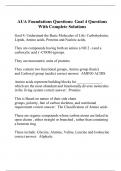
-
AUA Foundations Questions: Goal 4 Questions With Complete Solutions
- Exam (elaborations) • 26 pages • 2023
- Available in package deal
-
- $14.99
- + learn more
Goal 4: Understand the Basic Molecules of Life: Carbohydrates, Lipids, Amino acids, Proteins and Nucleic acids, They are compounds having both an amino (-NH 2 -) and a carboxylic acid ( -COOH-)groups. They are monomeric units of proteins They contain two functional groups, Amino group (basic) and Carboxyl group (acidic) correct answer: AMINO ACIDS Amino acids represent building blocks for _____________, which are the most abundant and functionally diverse molecules in the living sy...
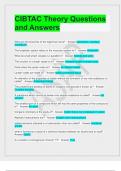
-
CIBTAC Theory Questions and Answers
- Exam (elaborations) • 6 pages • 2024
-
- $12.49
- + learn more
CIBTAC Theory Questions and Answers What are the branches of the trigeminal nerve? - Answer-ophthalmic, maxillary, mandibular The lymphatic system relies on the muscular system for? - Answer-movement What do small lymph vessles run parallel to? - Answer-Arteries and veins The function of a lymph vessle is to? - Answer-transport lymph to lymph ducts Fluid enters the lymph node via? - Answer-an afferent vessel Lymph nodes are made of? - Answer-solely connective tissue An altera...
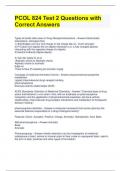
-
PCOL 824 Test 2 Questions with Correct Answers
- Exam (elaborations) • 5 pages • 2024
-
Available in package deal
-
- $13.39
- + learn more
PCOL 824 Test 2 Questions with Correct Answers Types of bonds often seen in Drug-ReceptorInteractions - Answer-Electrostatic Interactions: (strongest first) 1) Salt Bridges (ion-ion) (full charge on full charge Na+Cl-, much stronger) 2) Pi-Cation (ion-dipole) the ion-dipole interaction (i.e. a fully charged species interacting with the opposite charge of a dipole) 3) Neutral H-Bonds (dipole-dipole) 4) Van der waals (C to C) *Aliphatic chains to Aliphatic chains Aliphatic chains to ar...

-
The Etiology of Balkan Endemic Nephropathy: Still More Questions than Answers
- Exam (elaborations) • 12 pages • 2024
-
- $16.49
- + learn more
Figure 5. Excitation-emission matrix (EEM) spectra of well water samples collected from Bulgaria and the former Yugoslavia. BEN, Balkan endemic nephropathy. (A) Water sample from a nonendemic village in the former Yugoslavia. (B) Water sample from a nonendemic household in a Bulgarian BEN endemic village. (C) Water sample from a BEN household in an endemic village in the former Yugoslavia. (D) Composite EEM spectra resulting from subtraction of the spectra of two water samples collected in n...

-
Chem 219 Unit 4 Exam with Verified Solutions
- Exam (elaborations) • 15 pages • 2024
-
- $10.09
- + learn more
Chem 219 Unit 4 Exam with Verified Solutions What are the four halogen elements? - Answer -F, Cl, Br, I organohalide compounds - Answer -Organic molecules containing halogen atoms (F, Cl, Br, I) Examples of how organohalide compounds are used by humans - Answer -- have been found in marine life (algae, mollusks, sponges, etc.), bc they metabolize the high concentrations of inorganic chlorides and bromides that are found in the seas. - Industrially, organohalides find uses as solvents, inse...
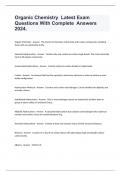
-
Organic Chemistry Latest Exam Questions With Complete Answers 2024.
- Exam (elaborations) • 4 pages • 2024
-
Available in package deal
-
- $9.49
- + learn more
Organic Chemistry - Answer The branch of chemistry which deals with carbon compounds, including those with no relationship to life. Saturated Hydrocarbon - Answer Contain only only carbon-to-carbon single bonds. The most chemically inert of all organic compounds. Unsaturated Hydrocarbon - Answer Contain carbon-to-carbon double or triple bonds. Carbon - Answer An element that has the capacity to share four electrons in order to achieve a more stable configuration. Hydrocarbon ...
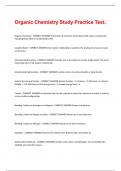
-
Organic Chemistry Study Practice Test.
- Exam (elaborations) • 6 pages • 2024
-
Available in package deal
-
- $11.49
- + learn more
Organic Chemistry Study Practice Test. Organic Chemistry - CORRECT ANSWER The branch of chemistry which deals with carbon compounds, including those with no relationship to life. Covalent Bond - CORRECT ANSWER Inter-atomic relationship created by the sharing of at least one pair of electrons. Saturated Hydrocarbon - CORRECT ANSWER Contain only only carbon-to-carbon single bonds. The most chemically inert of all organic compounds. Unsaturated Hydrocarbon - CORRECT ANSWER Contain car...

-
Chemistry for Embalmers Midterm Pre-Test 2024.
- Exam (elaborations) • 14 pages • 2024
-
Available in package deal
-
- $10.49
- + learn more
Chemistry for Embalmers Midterm Pre-Test 2024.The ________ for a ketone is R-CO-R - ANSWER General Formula All isomers are in the same class [ex: ketones] - ANSWER False When benzene's carbons lose a hydrogen, the ____ is formed - ANSWER methyl radical An organic compound with 7 carbons in it will be a - ANSWER liquid Open chained hydrocarbons are classified as - ANSWER Aliphatic Which of the following is not a term that refers to benzene - ANSWER 5 carbon ring The minimum num...
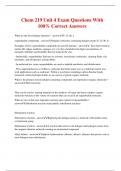
-
Chem 219 Unit 4 Exam Questions With 100% Correct Answers
- Exam (elaborations) • 15 pages • 2024
- Available in package deal
-
- $12.49
- + learn more
Chem 219 Unit 4 Exam Questions With 100% Correct Answers What are the four halogen elements? - answerF, Cl, Br, I organohalide compounds - answerOrganic molecules containing halogen atoms (F, Cl, Br, I) Examples of how organohalide compounds are used by humans - answer- have been found in marine life (algae, mollusks, sponges, etc.), bc they metabolize the high concentrations of inorganic chlorides and bromides that are found in the seas. - Industrially, organohalides find uses as solvent...

-
CHEM 210 FINAL EXAM TEST QUESTIONS 100% SOLUTIONS LATEST UPDATE 2023/2024
- Exam (elaborations) • 22 pages • 2023
-
- $12.09
- + learn more
CHEM 210 FINAL EXAM TEST QUESTIONS 100% SOLUTIONS LATEST UPDATE 2023/2024 What are the differences between aliphatic (including alkanes, alkenes,alkynes and cyclic compounds) aromatic hydrocarbons are. ALIPHATIC Hydrocarbon: Non-aromatic -Alkanes & CycloAlkanes:single bonds; saturated:Contain only carbon and hydrogen & C-C & C-H single bonds -Alkenes:double bond(s) -Alkynes: triple bond(s) *alkenes and alkynes are unsaturated: at least one C-C double or triple bond(s) AROMATIC H...

Do you wonder why so many students wear nice clothes, have money to spare and enjoy tons of free time? Well, they sell on Stuvia! Imagine your study notes being downloaded a dozen times for $15 each. Every. Single. Day. Discover all about earning on Stuvia


